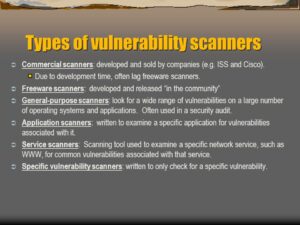Types of Vulnerability Scanners
Vulnerability Scanners
There are several different types of vulnerability scanners, each with different capabilities and features. These can include scheduling scans during supported hours or off-peak periods, running them whenever the user wants, and performing scans manually. Some also allow you to trigger scans programmatically, meaning that they automatically check your system for the latest threats.
These types of scanners are often part of penetration testing services, which charge a high price for finding vulnerabilities. A good vulnerability scanner should scan under these protective layers to find the weak points. By doing this, you can get an idea of how your system would fare if protections failed. This way, you can make any necessary adjustments.
Some vulnerability scanners target internal networks, while others target externally exposed systems. However, not all scanners will report the context of the vulnerability. For example, some scanners may miss security issues that can affect the entire network, resulting in a distorted picture of how the organization’s vulnerability exposure could affect its operations.
There are two main types of vulnerability scanners: network-based and host-based. Network-based scanners are used to identify vulnerabilities on a network, while host-based vulnerability scanners are used to identify weaknesses within a computer system. Network-based vulnerability scanners can identify unknown devices and perimeter points on a network. They also provide greater insight into the configuration settings and patch history of network hosts.

Types of Vulnerability Scanners
A vulnerability scanner can also identify weaknesses in software. For instance, if the software is built without input validation, it may be vulnerable to injection attacks. If a web application has no security checks, it could fall victim to a security vulnerability resulting from an insecure design. These vulnerabilities are more difficult to fix in production than to avoid them during SDLC.
An advanced vulnerability scanning solution can identify vulnerabilities across multiple network components and applications. The tool can provide comprehensive reports and key metrics for each vulnerability. It can also provide a simple patching process. It can even run continuous scans on a network portfolio. Depending on the needs of the organization, a vulnerability management solution can be a useful addition to a security strategy.
Another type of vulnerability scanner focuses on web applications. These scanners use a crawler to crawl a site and send probes to form-based systems. Some scanner vendors offer dedicated web application scanning, while others bundle it with other checks. When choosing a vulnerability scanner, be sure to research the features of the product. You don’t want to waste time and money on something that isn’t worth your time.